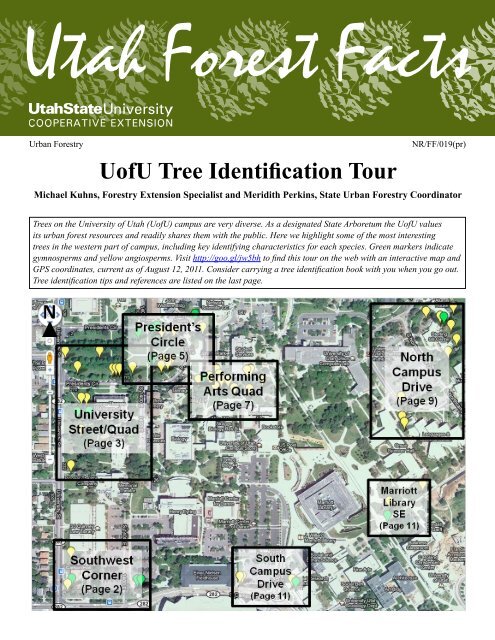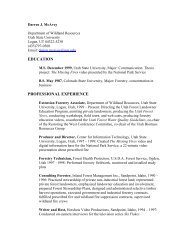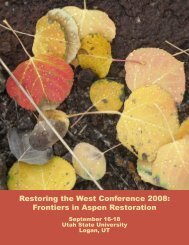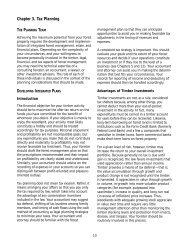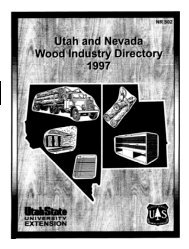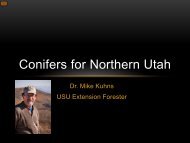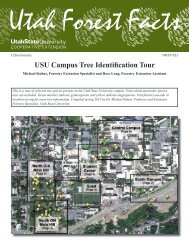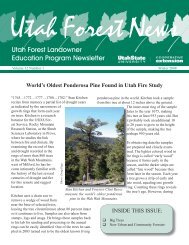UofU Tree Identification Tour - Forestry - Utah State University
UofU Tree Identification Tour - Forestry - Utah State University
UofU Tree Identification Tour - Forestry - Utah State University
Create successful ePaper yourself
Turn your PDF publications into a flip-book with our unique Google optimized e-Paper software.
Urban <strong>Forestry</strong><br />
NR/FF/019(pr)<br />
<strong>UofU</strong> <strong>Tree</strong> <strong>Identification</strong> <strong>Tour</strong><br />
Michael Kuhns, <strong>Forestry</strong> Extension Specialist and Meridith Perkins, <strong>State</strong> Urban <strong>Forestry</strong> Coordinator<br />
<strong>Tree</strong>s on the <strong>University</strong> of <strong>Utah</strong> (<strong>UofU</strong>) campus are very diverse. As a designated <strong>State</strong> Arboretum the <strong>UofU</strong> values<br />
its urban forest resources and readily shares them with the public. Here we highlight some of the most interesting<br />
trees in the western part of campus, including key identifying characteristics for each species. Green markers indicate<br />
gymnosperms and yellow angiosperms. Visit http://goo.gl/jw5bh to find this tour on the web with an interactive map and<br />
GPS coordinates, current as of August 12, 2011. Consider carrying a tree identification book with you when you go out.<br />
<strong>Tree</strong> identification tips and references are listed on the last page.
<strong>University</strong> Street/Quad<br />
Southwest Corner<br />
1 – Black Walnut (Juglans nigra). Chambered pith;<br />
pinnately compound leaves, typically missing terminal<br />
leaflet; round nut with indehiscent husk; chocolate color<br />
when older bark is broken; stout twigs. Fact: Stout twigs<br />
are common on trees with compound leaves.<br />
2 – Eastern<br />
Redcedar<br />
(Juniperus<br />
virginiana). Cones<br />
resemble berries;<br />
dioecious; this tree<br />
is a male; juvenile<br />
and adult foliage<br />
differ. Compare:<br />
Cones mature in 1<br />
year, so all cones<br />
on female trees<br />
are the same age;<br />
J. scopulorum<br />
matures in 2 years.<br />
<strong>Tree</strong> #1 – Black Walnut 3 – Red<br />
Horsechestnut<br />
(Aesculus x carnea). Dark green, palmately compound<br />
leaves with 5 leaflets; red flowers in panicles; somewhat<br />
prickly husk on fruit; small tree; this is a group of 3 trees;<br />
girdling root on eastern one. Compare: A. hippocastanum<br />
looks similar but has larger, lighter colored leaves with 7<br />
leaflets and larger, sticky buds.<br />
______<br />
61 – Ponderosa Pine (Pinus ponderosa). Needles in<br />
bundles of 2 & 3; woody cones with prickles; buds<br />
cinnamon brown; bark scaly, furrowed, becoming platy<br />
& orange-red at maturity; bark vanilla scented. Fact:<br />
This and Austrian pine are “hard pines” or “red pines”;<br />
pines with 5 needles per bundle are called “soft pines” or<br />
“white pines”.<br />
62 – Austrian Pine (Pinus nigra). Medium long needles<br />
in bundles of 2; woody cones with bumps rather than<br />
sharp prickles; prickles; buds white; bark gray-brown and<br />
not scaly. Fact: Like all hard pines, cones take 2 years to<br />
mature, and fascicles have heath; white or soft pines take<br />
1 year, no sheath.<br />
Ponderosa Pine Cone,<br />
With Prickles<br />
Austrian Pine Cone,<br />
No Prickles<br />
4 – Weeping European Beech (Fagus sylvatica var.<br />
‘Purpurea pendula’). Often looks like a pile of branches;<br />
purple or purple-green, entire leaves, or with very small<br />
teeth; zig-zag twigs; smooth gray<br />
bark; fruit a small nut in 4-part capsule.<br />
Fact: Always under 10 feet tall.<br />
5 – Japanese Zelkova (Zelkova<br />
serrata). Young bark with horizontal<br />
lenticels, becoming scaly and multicolored<br />
on older trees; fruit is a small<br />
drupe; red fall color. Note: This is a<br />
Japanese Zelkova, Young & Old Bark<br />
Page 2 Page 3<br />
very large, old specimen; Ulmaceae (elm) family.<br />
6 – Port Orford Cedar (Chamaecyparis lawsoniana).<br />
Small (1/4”), round female cones<br />
with wrinkled scales (Thuja cones<br />
are elongated); scaly foliage in<br />
flattened, drooping sprays with white<br />
X markings underneath; uncommon<br />
in <strong>Utah</strong>; a Juniperus scopulorum is<br />
located to the west of this tree. Fact:<br />
Also called Lawson falsecypress.
7 – Giant Sequoia (Sequoiadendron giganteum). Dense<br />
pyramid shape; leaves 1/8-1/2” long, blue-green and<br />
awl-shaped, point toward the branch tip, and stay on the<br />
tree 3-4 years; fruit a woody cone, oval, 1-1/2 to 3” long.<br />
Fact: Spongy bark helps tree resist fire injury in nature.<br />
8 – Lacebark or Chinese Elm (Ulmus parvifolia).<br />
Samaras ripen in fall; interlacing bark; leaves small,<br />
serrate, leathery, dark green and glabrous above, hairy<br />
beneath when young. Note: Very large, old specimen.<br />
9 – Hackberry (Celtis occidentalis). Very warty, ridged<br />
bark; leaves lanceolate and serrate, typically with nipple<br />
galls casued by insects; fruit dark purple. Compare:<br />
Native netleaf hackberry (C. reticulata) has broader,<br />
nearly entire leaves with yellow to orange-red fruit; both<br />
are in the Ulmaceae (elm) family.<br />
13 – Ohio Buckeye (Aesculus glabra). Leaves opposite,<br />
lighter green than red horsechestnut, palmately compound<br />
with 5 leaflets and no rusty hairs underneath; yellowgreen<br />
flowers. Compare: A. x carnea has darker leaves<br />
and A. hippocastanum has spinier fruit.<br />
14 – Red Horsechestnut (Aesculus x carnea). Leaves<br />
opposite, dark green, palmately compound, with 5<br />
leaflets; red flowers; somewhat prickly husk on fruit; tree<br />
matures quite small. Compare: A. hippocastanum has<br />
larger leaves and buds and much stickier buds. Group of 3<br />
Aesculus trees; girdling root on eastern one.<br />
President’s Circle<br />
<strong>Tree</strong>s 10 to 27 are Inside the Oval Driveway<br />
10 – Norway Maple (Acer platanoides). Milky sap<br />
when petioles broken (less in late summer); samaras<br />
with widely spreading wings; tight, ridged bark;<br />
opposite leaves. Fact: Use MADCap Horse to remember<br />
species with opposite leaves (maple, ash, dogwood,<br />
Caprifoliaceae, and horsechestnut).<br />
11 – Japanese Flowering Cherry (Prunus serrulata).<br />
Glands (2-4) on petiole near base; flowers pink; often<br />
grafted on a standard 4-6’ up; prominent horizontal<br />
lenticels on shiny, reddish bark. Note: This is likely<br />
‘Kwanzan’ variety. Group of 4 trees.<br />
12 – Kentucky Coffeetree (Gymnocladus dioicus).<br />
Fruit a fairly large, thick legume with 1/2” seeds;<br />
leaves 2x pinnately compound, dark blue-green; coarse<br />
texture in winter;<br />
crowns somewhat<br />
narrow. Fact:<br />
Either dioecious<br />
or polygamodioecious,<br />
so there<br />
is no guarantee of<br />
a fruitless male;<br />
‘Espresso” is<br />
a reliably male<br />
cultivar. Many of<br />
these trees in this<br />
area.<br />
<strong>Tree</strong> #12 – Kentucky Coffeetree<br />
<strong>Tree</strong> #14 – Red Horsechestnut<br />
15 – Yellow Horsechestnut (Aesculus octandra).<br />
Opposite, palmately compound leaves with 5 leaflets;<br />
yellow flowers; fruit a smooth capsule with 2 seeds.<br />
Compare: Gets larger than A. glabra.<br />
16 – Green Ash (Fraxinus pennsylvanica). Opposite,<br />
bright green leaves in summer turning yellow in fall; leaf<br />
scar half circular, straight or shallow notched across top.<br />
Compare: Cross-hatching of bark less distinct than for F.<br />
americana.<br />
Green Ash Bark, White Ash Bark<br />
17 – Nootka Falsecypress<br />
(Xanthocyparis<br />
[was Chamaecyparis]<br />
nootkatensis). Pendulous<br />
branches; looks like it<br />
belongs in a Dr. Seuss<br />
book; leaves lack white<br />
markings underneath.<br />
Cones up to 1/2”; 2 years<br />
to mature. Compare:<br />
Port-Orford cedar has<br />
<strong>Tree</strong> #55 – Spanish Fir<br />
smaller cones and white markings under leaves.<br />
18 – Spanish Fir (Abies pinsapo). Leaves dark green<br />
above and whitish beneath, short, stiff, sharp, and not<br />
flattened in cross-section; cones upright, 4-8” long. Fact:<br />
Heat and drought tolerant.<br />
<strong>Tree</strong> #19 – English Hawthorn Trunk<br />
19 – English<br />
Hawthorn<br />
(Crataegus<br />
laevigata). Leaves<br />
deeply lobed; flowers<br />
red to pale pink in<br />
small clusters; thorns<br />
1” long but may not<br />
be present. Note:<br />
trunk like a bundle of<br />
stems.<br />
Page 4 Page 5<br />
20 – Saucer Magnolia (Magnolia x soulangiana). Large,<br />
deciduous, entire leaves; large (5” to 10”) white, pink, or<br />
purple flowers with 9 tepals (petals); hairy buds, stipular<br />
scars, and smooth gray bark like all magnolias; gets to be<br />
fairly large. Fact: Hybrid of M. liliiflora (5 tepals) and M.<br />
denudata (7 tepals).<br />
21 – Lavalle<br />
Hawthorn<br />
(Crataegus x<br />
lavallei). Leaves<br />
shiny dark green<br />
on top, finely<br />
pubescent beneath;<br />
twigs very hairy at<br />
first but becoming<br />
glabrous; fruit fairly<br />
large (5/8” to 3/4”)<br />
pome turning bright<br />
orange-red when<br />
<strong>Tree</strong> #21 – Lavalle Hawthorn, Immature<br />
Fruit<br />
mature. Fact: Hybrid<br />
of C. crusgalli and<br />
C. pubescens. Old specimen.<br />
22 – European Beech (Fagus sylvatica). Leaves entire<br />
leaves or with very small teeth; zig-zag twigs; smooth<br />
gray bark; fruit a small nut in 4-part capsule (present in<br />
summer and fall); sharp pointed buds. Note: This cultivar<br />
is semi-fastigiate and contorted, but there are many other<br />
cultivars with different shapes, leaf colors, etc.
23 – Blue Spruce (Picea pungens). Often bluish needles;<br />
needles diamond shaped in cross section. Cones larger<br />
than Engelmann but smaller than Norway; scales with<br />
erose (toothed) margins; hang down. Rosette bud scales.<br />
Fact: Spruces have female cones above, male below to<br />
reduce chances of sefl pollination. Remember “Sharp<br />
Spruces” – pointed tips.<br />
24 – Norway<br />
Spruce (Picea<br />
abies var.<br />
‘Pendulum’).<br />
Cones 4-7” long.<br />
Branchlets often<br />
pendulous. Fact:<br />
Many cultivars<br />
with different<br />
shapes and sizes.<br />
27 – Littleleaf European Linden, Tilia cordata. Dark<br />
green, irregularly heart-shaped leaves. Fruit several<br />
nutlets borne on a light green bract. Dense conical<br />
form. Compare: Smaller leaves, flowers, and fruit than<br />
American linden. Compare: Tilia x euchlora (to the west)<br />
has longer petioles, leaves non-glaucous underneath.<br />
Performing Arts Quad<br />
<strong>Tree</strong> #24 – Norway Spruce<br />
cv. ‘Pendula’<br />
25 – White Fir<br />
(Abies concolor).<br />
Fir cones upright<br />
(near tree top),<br />
disintegrate.<br />
Needles flat and<br />
white fir has<br />
longer needles than subalpine fir. Broader crown, blue<br />
instead of green color, and larger cones compared to<br />
subalpine. Fact: Remember “Flat, Friendly Firs”.<br />
26 – Gambel<br />
or Scrub<br />
Oak (Quercus<br />
gambellii).<br />
In white oak<br />
group (rounded<br />
lobes, sinuses<br />
or no lobes;<br />
acorns mature<br />
in one season,<br />
glabrous inner<br />
shells rather<br />
than downy,<br />
warty caps;<br />
tyloses). Leaves<br />
smaller than<br />
white oak; tree<br />
White Fir Foliage<br />
often shrubby;<br />
sprouts from roots. Acorn short or no stalk. Note: This is<br />
probably a hybrid from by Dr. Walter P. Cottam.<br />
Page 6<br />
28 – American Elm (Ulmus americana). Leaves<br />
glabrous or slightly rough on top, 4-6” long, unequal base<br />
(Siberians are equal). Samaras notched at tip, ripen in<br />
spring. Note: Broken bark w/ alternating light and dark<br />
layers, black on bark caused by mildew on honeydew<br />
from scale insects.<br />
29 – Scots or<br />
Scotch Pine<br />
(Pinus sylvestris).<br />
Butterscotch colored<br />
upper bark; twisted,<br />
blue-green needles,<br />
medium length, 2<br />
per fascicle; fairly<br />
small woody cones<br />
with no prickle.<br />
<strong>Tree</strong> #28 – American Elm<br />
<strong>Tree</strong> #29 – Scots Pine Upper Bark<br />
30 – <strong>Tree</strong>-of-heaven or Ailanthus (Ailanthus altissima).<br />
Compound leaves 1’ to 2-1/2’ long with 11 to 41 leaflets;<br />
musty smell when crushed. Coarse twigs. Flowers<br />
dioecious (some perfect). Smooth gray bark. Samara has<br />
one seed and hangs in bunches, orange-red when mature.<br />
<strong>Tree</strong> #31 – Ginkgo<br />
31 – Ginkgo or<br />
Maidenhair <strong>Tree</strong><br />
(Ginkgo biloba).<br />
Fan-shaped leaves;<br />
dichotomous<br />
venation; on<br />
short spur shoots<br />
on older stems.<br />
Golden fall color.<br />
Fact: Dioecious;<br />
female trees have<br />
bad smelling<br />
fruit; deciduous<br />
gymnosperm.<br />
32 – European Hornbeam (Carpinus betulus).<br />
Somewhat broad crowned. Fruit a nutlet with distinctive<br />
3-lobed bract in loose clusters. Leaves doubly serrate.<br />
Bark smooth and stem is sinewy. Fact: Often found in<br />
landscape as upright, tight-crowned variety (see #38).<br />
33 – Goldenchain <strong>Tree</strong> (Laburnum x watereri). Leaves<br />
trifoliolate (3 leaflets). Bright yellow flowers in clusters<br />
Page 7<br />
that hang down like<br />
a chain. Fruit a 1” to<br />
2” long legume. Fact:<br />
Hybrid of L. alpinum and<br />
L. anagyroides.<br />
34 – Goldenraintree<br />
(Koelreuteria<br />
paniculata). Once<br />
pinnately compound<br />
leaves; leaflets toothed<br />
and sometimes deeply<br />
lobed. Flowers bright <strong>Tree</strong> #32 – European Hornbeam<br />
yellow in large bunches.<br />
Fruit a papery capsule resembling a lantern, with 3 hard<br />
black seeds inside.<br />
<strong>Tree</strong> #35 – Cork Oak Bark<br />
35 – Cork Oak<br />
(Quercus suber).<br />
Very thick, corky,<br />
ridged bark. Leaves<br />
with small, sharp<br />
serrations and<br />
bristle tips but no<br />
lobes. Acorns 1”<br />
to 1-1/2” long with<br />
scaly cap. Fact:<br />
Member of the red<br />
oak group.
36 – Mongolian Oak (Quercus mongolica). Leaves<br />
with large, rounded teeth or shallow lobes. Bark thick<br />
and furrowed. Warty acorn cap. Fact: Q. suber and Q.<br />
mongolica are very rare in <strong>Utah</strong>.<br />
be lobed. White fruit. Fact: Mulberries are dioecious, so<br />
fruitless (male) varieties are often planted. Compare: M.<br />
rubra leaves are scabrous above, hairy beneath, unlobed<br />
on old shoots; red to black fruit.<br />
North Campus Drive<br />
<strong>Tree</strong> #37 – European White Birch<br />
37 – European<br />
White Birch (Betula<br />
pendula). Smooth,<br />
bright white bark<br />
with horizontal<br />
lenticels; not papery.<br />
Doubly serrate<br />
leaves; sometimes<br />
lobed (cut-leaved<br />
varieties). Fruit a<br />
nutlet in catkins.<br />
Fact: Commonly<br />
planted as cutleaved<br />
variety. Name<br />
(pendula) refers to<br />
hanging branches.<br />
38 – European Hornbeam (2) (Carpinus betulus var.<br />
‘Fastigiata’). Leaves doubly serrate. Bark smooth and<br />
stem is sinewy. Compact, upright crown. Note: Same<br />
species as #32 but with tighter, more upright crown.<br />
39 – English Oak (Quercus robur var. ‘Fastigiata’).<br />
Acorn with long peduncle or stalk (sometimes called<br />
pedunculate oak).<br />
Lobes at the base<br />
of the leaf blade<br />
resemble earlobes.<br />
Fact: Q. robur<br />
can have a broad,<br />
spreading canopy,<br />
English Oak Acorn Peduncle<br />
English Oak Foliage<br />
with ‘Earlobes’<br />
but this upright<br />
form (‘Fastigiata’)<br />
is more commonly<br />
planted in <strong>Utah</strong>.<br />
40 – White Mulberry (Morus alba). Leaves are smooth<br />
and shiny above, nearly glabrous below, may or may not<br />
41 – Siberian Elm (Ulmus pumila). Small leaves (1-3”<br />
long), glabrous above, nearly equal base. Samara wing<br />
margin deeply notched at tip; ripens in spring. Bark gray,<br />
often darkly stained by slime flux. Compare: See U.<br />
americana, #28.<br />
42 – Black<br />
Locust (Robinia<br />
pseudoacacia).<br />
Small legume fruit.<br />
Spines present.<br />
Interlacing bark.<br />
Borer damage<br />
common. Fact:<br />
Spines are modified<br />
stipules, while<br />
thorns are modified<br />
branches. Some<br />
legume fix nitrogen<br />
in soil.<br />
<strong>Tree</strong> #41 – Siberian Elm Bark<br />
43 – White<br />
<strong>Tree</strong> #42 – Black Locust Bark<br />
Ash (Fraxinus<br />
americana). Leaves compound, dark green above and<br />
whitish below, purplish fall color; leaf scar U-shaped<br />
with deep to shallow notch across top. Compare: F.<br />
americana bark more distinctively cross-hatched than F.<br />
pennsylvanica.<br />
44 – Sycamore<br />
Maple (Acer<br />
pseudoplatanus).<br />
Green buds in<br />
winter. Bark scaly<br />
and gray, flaking off<br />
to expose orange<br />
inner bark. Leaves<br />
sharply toothed,<br />
dark green. Samaras<br />
in 6-12” long,<br />
drooping panicles.<br />
<strong>Tree</strong> #44 – Sycamore Maple<br />
Page 8 Page 9<br />
45 – Common<br />
Smoketree (Cotinus<br />
coggyria var. ‘Royal<br />
Purple’). Flowers tiny;<br />
fruit a small drupe.<br />
Flowers and fruit<br />
showy; held in clusters<br />
6-8” across with<br />
hairy pink or purple<br />
stalks. Fact: Is in the<br />
family Anacardiaceae<br />
(Rhus, Pistacia,<br />
Toxicodendron, etc.),<br />
and is dioecious.<br />
<strong>Tree</strong> #45 – Common Smoketree
46 – Dawn<br />
Redwood<br />
(Metasequoia<br />
glyptostroboides).<br />
Leaves opposite<br />
and deciduous.<br />
Fruit a 1” diameter,<br />
slightly elongated<br />
cone with 20-30<br />
triangular scales.<br />
Fact: Baldcypress<br />
has a similar look<br />
but alternate leaf<br />
arrangement.<br />
<strong>Tree</strong> #46 – Dawn Redwood<br />
47 – Horsechestnut (Aesculus hippocastanum). Leaves<br />
with 7 large leaflets. Flowers white to light yellow<br />
with red spots. Fruit a prickly capsule with 1-3 kernels.<br />
Compare: #13, #14, and #15.<br />
50 – Bur Oak<br />
(Quercus<br />
macrocarpa).<br />
Leaves lobed below<br />
middle and toothed<br />
above. Acorn cap<br />
fringed, surrounds<br />
half or more of<br />
acorn. Group of 7<br />
trees. Fact: In the<br />
white oak group.<br />
51-European Bur Oak Immature Acorn & Leaves<br />
Mountain-ash or<br />
Rowan (Sorbus aucuparia). Compound leaves, serrate<br />
margins and orange-red fall color. Buds hairy; not sticky.<br />
Fruit a berry-like pome, 1/4-1/2” diameter, orange-red.<br />
South Campus Drive<br />
Marriott Library SE<br />
<strong>Tree</strong> #48 – Yellow-poplar Leaf<br />
48 – Yellow-poplar<br />
or Tuliptree<br />
(Liriodendron<br />
tulipifera). Leaves<br />
4-lobed with base<br />
and tip flat. Large<br />
yellow-green<br />
flowers become<br />
a tulip-shaped<br />
fruit (aggregate<br />
of samaras). Stem<br />
has diaphragmed<br />
pith. Fact: In the<br />
Magnoliaceae.<br />
49 – Russian-olive (Elaeagnus angustifolia). Leaves<br />
silvery, scaly, margins entire. Fruit a 1/4-1/2” silveryellow<br />
to<br />
reddish<br />
drupe. Twigs<br />
sometimes with<br />
spines. Twigs,<br />
leaves, and fruit<br />
covered with<br />
scales. Note:<br />
This species is<br />
a weed and in<br />
some places in<br />
<strong>Utah</strong> is illegal to<br />
grow.<br />
<strong>Tree</strong> #49 – Russian-olive<br />
Page 10<br />
<strong>Tree</strong> #51 – Europeam Mountain-ash Immature Fruit<br />
52-Bur Oak (Quercus macrocarpa). See #50.<br />
53-Bigtooth or – Canyon Maple (Acer grandidentatum).<br />
Leaf margins palmately lobed, but lobe margins entire<br />
or divided into additional lobes. Fruit U-shaped samaras.<br />
Fact: Considered a<br />
hard maple. Though<br />
a <strong>Utah</strong> native, most<br />
common cultivar is<br />
grafted onto sugar<br />
maple rootstocks.<br />
Compare: Similar<br />
to A. saccharum<br />
but shrubbier and<br />
smaller.<br />
<strong>Tree</strong> #53 – Bigtooth Maple<br />
54 – Sycamore Maple (Acer pseudoplatanus). See #44.<br />
55 – Spanish Fir (Abies pinsapo). See #18.<br />
56 – Fastigiate European Beech (Fagus sylvatica var.<br />
‘Fastigiata’). Tightly fastigiate form. Purple, entire leaves<br />
or with very small teeth. Zig-zag twigs. Smooth gray<br />
bark. Small nut in a 4-part capsule.<br />
57 – Incensecedar (Calocedrus decurrens). Scaly foliage<br />
clasping and flattened along stem in 4s; 1/4” long on<br />
youngest twigs, 1/2” long on older twigs; lateral pairs<br />
hide facial pairs.<br />
Cones 3/4” to 1-1/2”<br />
long with 6 (5<br />
apparent) scales; 2<br />
scales elongated and<br />
look like duck’s bill.<br />
Somewhat narrow<br />
crowned.<br />
<strong>Tree</strong> #57 – Incensecedar<br />
58 – Eastern<br />
Redbud (Cercis<br />
canadensis). Small<br />
tree with heartshaped<br />
leaves with<br />
Page11<br />
entire margins. Pink, pea-like flowers. Fruit a flattened<br />
legume 2-4” long. Gray to cinnamon-colored bark.<br />
59 – Mimosa or Silktree (Albizia julibrissin). Showy<br />
flowers with many<br />
1” long or longer<br />
pink stamens. Fruit a<br />
thin, flattened, 4-6”<br />
long legume. Leaves<br />
doubly compound<br />
with 40-60 small<br />
leaflets.<br />
60 – Curlleaf<br />
Mountainmahogany<br />
(Cercocarpus<br />
ledifolius).<br />
<strong>Tree</strong> #58 – Eastern Redbud<br />
Broadleaved<br />
evergreen; leaves last 2 years. Leaves with entire,<br />
revolute margins; leathery. Fruit a small achene with 2-3”<br />
long, hairy, persistent, corkscrewed style. Fact: Shrubby<br />
tree.
More Information<br />
For definitions of botanical and tree-related terms look<br />
at the <strong>Tree</strong> and Botanical Glossary at http://forestry.usu.<br />
edu/htm/treeid/tree-and-botanical-glossary/. For detailed<br />
information on most trees included here look in A Guide<br />
to the <strong>Tree</strong>s of <strong>Utah</strong> and the Intermountain West by Mike<br />
Kuhns from <strong>Utah</strong> <strong>State</strong> <strong>University</strong> Press. Also visit the<br />
<strong>Tree</strong> Browser website at http://treebrowser.org.<br />
Here are some other good tree identification resources:<br />
General tree ID info<br />
http://forestry.usu.edu/htm/treeid<br />
Digital Atlas of the Vascular Plants of <strong>Utah</strong><br />
http://earth.gis.usu.edu/plants/<br />
Westminster College <strong>Tree</strong> List<br />
http://goo.gl/zgRGg<br />
Virginia Tech Dendrology Website<br />
http://dendro.cnre.vt.edu/<br />
<strong>Tree</strong> <strong>Identification</strong> Tips and Information<br />
•Use an identification key that is as local as possible. For<br />
an example look at the Logan Canyon tree key at http://<br />
forestry.usu.edu/htm/treeid.<br />
•Keys with photographs or drawings are much more useful<br />
than those that are text only.<br />
•In winter look for plant parts like fruit and leaves on the<br />
ground. Also learn to recognize twig features like buds,<br />
leaf scars, lenticels, and pith.<br />
•When using a key, look for reasons to rule out plants that<br />
seem wrong so you can narrow down your choices.<br />
•Use an identification key that is as local as possible. For<br />
an example look at the Logan Canyon tree key at http://<br />
forestry.usu.edu/htm/treeid. Use an identification key that<br />
is as local as possible. For an example look at the Logan<br />
Canyon tree key at http://forestry.usu.edu/htm/treeid.<br />
•Become familiar with terminology and plant anatomy as<br />
much as possible.<br />
•Visit arboreta, botanical gardens, and other plant collections.<br />
Labeled collections can be especially valuable.<br />
Arboreta and other plant collections exist in <strong>Utah</strong> at <strong>Utah</strong><br />
<strong>State</strong> <strong>University</strong> (http://earth.gis.usu.edu/trees), USU’s<br />
<strong>Utah</strong> Botanical Center (http://utahbotanicalcenter.org/htm/<br />
innovation/demonstration/vargaarboretum) and Ogden<br />
Botanical Center (http://extension.usu.edu/weber/htm/horticulture),<br />
BYU (http://treetour.byu.edu), the <strong>University</strong> of<br />
<strong>Utah</strong> and Red Butte Garden (http://www.redbuttegarden.<br />
org), and the Jordan Valley Water Conservancy District’s<br />
Conservation Garden Park (http://conservationgardenpark.<br />
org).<br />
•Visit commercial nurseries to observe unusual plants with<br />
labels.<br />
•Take a class. Contact your county Extension office and<br />
ask what kind of educational opportunities they have<br />
available. Visit http://extension.usu.edu/. Example: Salt Lake County Extension information<br />
can be found at http://extension.usu.edu/saltlake.<br />
•Consider becoming a USU Extension Master Gardener<br />
(http://utahmastergardeners.usu.edu) or Master Naturalist<br />
(http://utahbotanicalcenter.org/htm/education/adults/utahmasternaturalist).<br />
<strong>Utah</strong> <strong>State</strong> <strong>University</strong> is committed to providing an environment free from harassment and other forms of illegal discrimination based on race, color, religion, sex, national origin, age (40<br />
and older), disability, and veteran’s status. USU’s policy also prohibits discrimination on the basis of sexual orientation in employment and academic related practices and decisions. <strong>Utah</strong><br />
<strong>State</strong> <strong>University</strong> employees and students cannot, because of race, color, religion, sex, national origin, age, disability, or veteran’s status, refuse to hire; discharge; promote; demote; terminate;<br />
discriminate in compensation; or discriminate regarding terms, privileges, or conditions of employment, against any person otherwise qualified. Employees and students also cannot<br />
discriminate in the classroom, residence halls, or in on/ off campus, USU-sponsored events and activities. This publication is issued in furtherance of Cooperative Extension Work, Acts of<br />
May 8 and June 30, 1914, in cooperation with the U. S. Department of Agriculture, Noelle Cockett, Vice President for Extension and Agriculture, <strong>Utah</strong> <strong>State</strong> <strong>University</strong>. Published May 2012.<br />
Page 12


